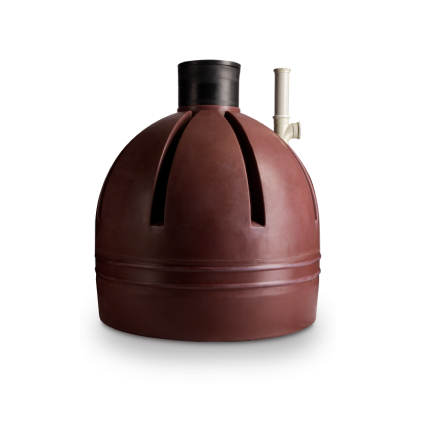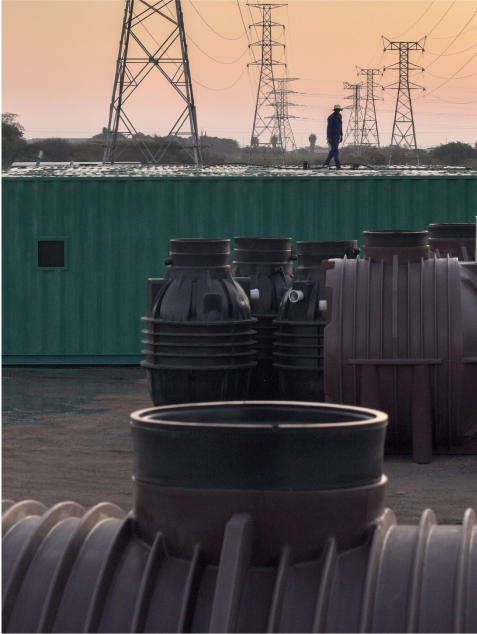Septic Tanks
Our septic tanks feature an inner chamber for cleaner effluent discharge and better soak-away performance. Paired with infiltration chambers, they offer cost-effective, efficient on-site sanitation.
The purpose of a septic tank
A septic tank’s purpose is to collect wastewater, and then separate and partially decompose as much heavy organic material as possible. The settled sewage can then be discharged into the sub-soil through a soakaway system or undergo further biological treatment for non-potable applications.
The main components
A tank
Installed underground, the tank collects sewage and allows bacterial activity to decompose it. A septic tank typically removes around 40% of the wastewater's organic load.
A soakaway drainage system
After solids settle in the tank, effluent is discharged to a soakaway drainage system for further treatment.
The soil
The soil surrounding the soakaway provides the final treatment and disposal of the effluent.
How it works

First chamber
Sewage enters the primary settlement chamber, where the heavier organic materials separate from the liquids. The heavier organic material settles to the bottom as sludge which is then partially decomposed by anaerobic bacteria over time.
Lighter materials like fats, oils, and grease accumulate as a scum layer on the water surface. This natural separation within a septic tank process allows a relatively solid-free effluent to form in the mid-section water column.
Note: Sizing the septic tank correctly is crucial to ensure a minimum retention period of 24 hours.
Second chamber
This chamber or inner baffle is designed to extract water from the clearest, most solid free zone of the primary settlement tank.
Septic tank drainage
A soakaway (French drain or leach field) is essential for allowing treated wastewater to percolate into the soil, further purifying it before reaching groundwater or surface waters such as rivers, lakes, and estuaries.
Important
- A soakaway drainage system should be adequately sized to allow for complete sub-soil disposal of the daily generated waste flow. The size is determined by an on-site percolation test (as per SANS 10400-P).
- A loamy or sandy soil profile is required for suitable percolation.
- A high groundwater table, waterlogged or clay soil, as well as rocky sub-terrain is usually unsuitable for the construction of a soakaway.
- Soakaways should never be installed in dolomitic areas due to the risk of sinkhole formation.
Types of soakaways
- Conventional soakaways entail excavating trenches in the subsoil, filling them with rocks, gravel, and perforated pipes. This allows gradual seepage and effluent absorption into the soil. Note: We discourage using car tires in soakaways as the rubber impedes percolation when in contact with the soil.
- Infiltration Chambers are less-invasive, cost-effective alternatives that enhance post-septic tank treatment efficiency. They foster the formation of a bacterial bio-mat, which further digests organic waste. As the bio-mat grows, soil microbes consume it, creating a mini ecosystem in the subsoil, resulting in highly treated secondary effluent.
Maintenance
It is recommended to desludge a septic tank annually (at the very least) to ensure that the hydraulic retention in the septic tank is not being compromised by accumulating volumes of sludge and/or scum. The services of a mobile tanker is needed to transport this material to a wastewater treatment plant.
Ideal applications
Areas with no connection to a sewer line.
Locations with normal or sandy soil suitable for effluent absorption.
Areas with a low groundwater level to protect groundwater sources.
Key differentiators
Certified quality
The only SABS-certified septic tanks in Africa.
Scalability
Our septic tank solutions are available in modular units for increased capacity.
Engineered to last
Our plastic septic tanks are specifically designed to cope with stressors of severe underground conditions.
Adaptability
Can be paired with our infiltration chambers for a less-invasive, more cost-effective alternative than conventional French drains.


